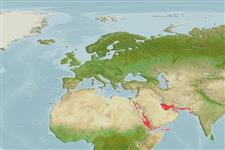Environment: milieu / climate zone / depth range / distribution range
البيئة
بحري قاعية التغذية و المعيشة; نطاق العمق 0 - 100 m (Ref. 114953). Subtropical; 28°N - 12°N, 33°E - 68°E (Ref. 114953)
Western Indian Ocean; Persian Gulf, and Arabian and Red Seas.
Length at first maturity / الحجم / وزن / العمر
Maturity: Lm ?, range 83 - ? cm
Max length : 120 cm WD ذكر/ مختلط الجنس; (Ref. 8630)
A benthic species often found in very shallow water near the coast and offshore on the continental shelf (Ref. 9909, Ref.114953). Feed on small mollusks and bony fishes (Ref. 12951). Ovoviviparous (Ref. 50449). Produces up to 10 pups a litter, mainly from May to October (in the Red Sea region) (Ref. 114953). Size at least 171 cm TL. Males matures at ca. 83 cm TL, birth size at ca. 29 cm TL (Ref.114953). Utilized where it occurs but information lacking (Ref. 9909).
Life cycle and mating behavior
النضج | التكاثر | وضع البيض | بيض | الخصوبة | Larvae
Exhibit ovoviparity (aplacental viviparity), with embryos feeding initially on yolk, then receiving additional nourishment from the mother by indirect absorption of uterine fluid enriched with mucus, fat or protein through specialised structures (Ref. 50449).
Compagno, L.J.V., 1999. Checklist of living elasmobranchs. p. 471-498. In W.C. Hamlett (ed.) Sharks, skates, and rays: the biology of elasmobranch fishes. Johns Hopkins University Press, Maryland. (Ref. 35766)
IUCN Red List Status (Ref. 130435)
استخدامات بشرية
مزيد من المعلومات
مراجعالأستزراع المائيملف الأستزراع المائيسلالاتجينيElectrophoresesالتوريثالأمراضمعالجةNutrientsMass conversion
أدوات
تقارير خاصة
Download XML
مصادر علي الأنترنت
Estimates based on models
Preferred temperature (Ref.
123201): 24.7 - 29.1, mean 27.9 °C (based on 1002 cells).
Phylogenetic diversity index (Ref.
82804): PD
50 = 0.5156 [Uniqueness, from 0.5 = low to 2.0 = high].
Bayesian length-weight: a=0.00389 (0.00138 - 0.01094), b=3.05 (2.82 - 3.28), in cm total length, based on LWR estimates for this (Sub)family-body shape (Ref.
93245).
مستوى غذائي (Ref.
69278): 4.1 ±0.67 se; based on food items.
المرونه (Ref.
120179): منخفض, الحد الزمني الأدني لتضاعف عدد أفراد المجتمع 4.5-14 سنة (Fec assumed to be <100).
Fishing Vulnerability (Ref.
59153): Very high vulnerability (90 of 100).
